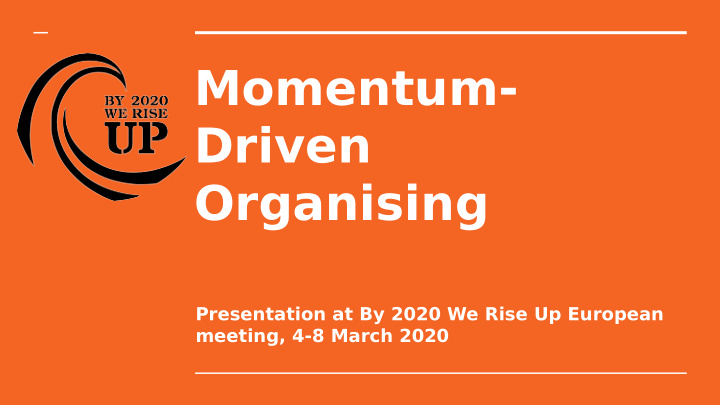



Momentum- Driven Organising Presentation at By 2020 We Rise Up European meeting, 4-8 March 2020
TWO DOMINAT TRADITIONS Structure Based Organising & Mass Protest
Saul Alinsky Ella Baker Structure Based Organising
Key Features of Structure Tradition - Deep Leadership Development and 1on1s - Concrete, winnable demands targeted at decision makers - Strong organisations → organised people and organised money
Frances Fox Piven Martjn Luther King Jr Mass Protest
Key Features of Mass Protest - Grows through moments of the whirlwind, and sometimes also fizzles quickly - Broad demands that speak to high ideals that are not necessarily “winnable” - Mass escalating, nonviolent direct action
Two Views of Power Monolithic Power Social Power
STRUCTURE MASS PROTEST Theory of Change We leverage the power of a base over decision- By engaging in mass disruption to the status quo, makers to win concrete reforms & quality of life we create a crisis and change the political weather. over the long term. Tactics + Demands Lower risk, gradual escalation (if any); focused on Mass civil disobedience & escalated action building leadership and capacity; Demands; Popular demands that appeal to a Demands: Specific & actionable broad public & change what is winnable. Organization 1-on-1 relationships; leadership comes from within Mass trainings & anyone who is compelled can the community join -- as many people as possible should take action! Measuring Success Incremental reforms that bring concrete Large shifts in public opinion. improvement in people’s lives.
Ella Gandh i Mass Bak er Structure Protest Marshall MLK Ganz
Momentum Driven Organising By integrating the best of structure-based organising and mass protest we can build movements that can scale up and win big!
Cycle of Momentum
Active Popular Support
Case Study: Same Sex Marriage (US) 1996 2010 2017
Target the Public
Which side are you on? Nashville, 1960
3.5% “Outcomes of over 300 nonviolent and violent campaigns worldwide from 1900-2006, none of the cases failed after achieving the active and sustained participation of just 3.5 percent of the population -- and some of them succeeded with far less than that.” - Erica Chenoweth Based on movements against dictatorships, for secession or against occupatjon => Few from “democratjc” regimes more capable of cooptjng oppositjon
Two Essentjal Elements of Popular Support Win the support & Sustained partjcipatjon sympathy of the majority in the movement. of the public . Passive Actjve
Moral Moral Choice Movement across this Choice Moral spectrum isn’t always the Choice result of conscious decision making. Often, people shift because an effective action reframes the basic moral questions behind an issue that is otherwise seen as too abstract or complex. It makes people emotionally connect to the issue and choose sides. Polarisation
Polarisation is how you target the public Keys to polarisation: 1. Make it simple 2. Make it matter
“Activists assume that because something is true, it will be meaningful to the people we’re trying to reach. But in fact, the opposite is often the case: if something is meaningful, people believe it to be true” - Center for Story-Based Strategy
Instrumental demands: What is winnable with the leverage we have? Can we force a concession? What is deeply felt only by our members? Is there a clear solution? Symbolic demands : What are the most popular issues around our movement? What is deeply felt by our active+passive supporters? What will polarise the public and dramatise a social problem ?
Why symbolic demands? - Open up room for instrumental wins - Create wiggle room for experimenting with different solutions - Give people a standard they can measure proposals against - Reach more people
Escalation
DIFFERENT SCALES OF ESCALATION: 1. Small actions a. Dilemma & symbolic actions b. Replicable distributed actions 2. Trigger events 3. Moments of the whirlwind
Trigger event: a highly publicised incident that dramatically reveals a critical social problem to the public in a vivid way. It focuses the public’s attention on the issue in a way that enables polarisation. Can be external to the movement or created by the movement.
Absorption
Mass Training
BRINGING PEOPLE IN AT SCALE ● Mass Training ● SWARM→ Role allocation ● Email lists/social media/Messaging apps ● And others...
MAJOR KEYS FOR ABSORPTION ● Have as few layers to your structure as possible ● Enable people to take action as quickly as possible ● Have DNA- principles
Note on Structure
Roles Principles 1.Everybody has a role and you need to hold your role 2.Your role is flexible 3.All roles are about support
Centralised vs. Decentralised Structure Mass Protest Decision-making and Coordinated by shared communication are top- strategy, not top leadership down Momentum Training
Extinction Rebellion
Relational Culture
“Culture eats strategy for breakfast”
Culture: Principles
Cosecha: Principles
Absorption & Escalation
Cycle of Momentum
Recommend
More recommend